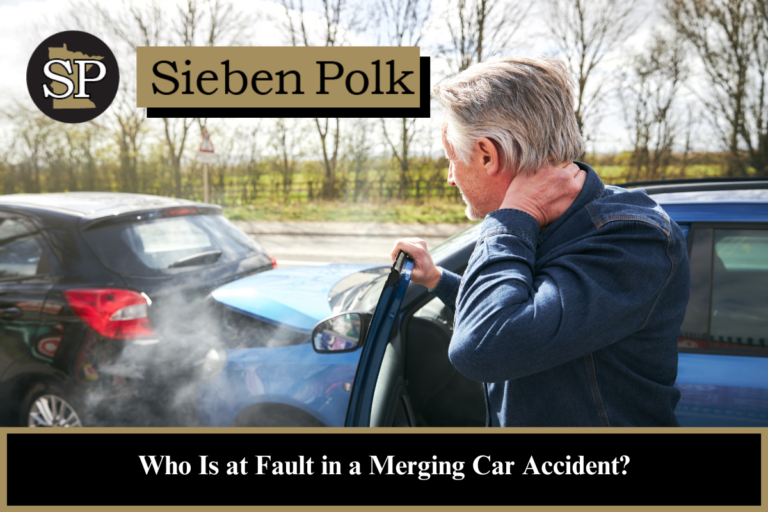Determining fault can be complex when two merging vehicles collide. The drivers often share fault, but one party may be solely responsible for the accident. Our Minnesota car accident lawyers can help you determine who is at fault in a merging accident and pursue compensation from all liable parties. Contact us online or call (651) 437-3148 to schedule your free consultation.
- A merging accident occurs when two vehicles collide while maneuvering within the same traffic lane.
- Minnesota’s merging rules require drivers to yield to other vehicles before merging.
- Merging drivers are often at fault for car accidents, but the other driver can also be at fault if they were negligent or otherwise driving irresponsibly.
- If someone else is at fault for your merging accident, our attorneys can help you gather evidence to substantiate your claim for compensation.
What Is a Merging Accident? How Do They Happen?
A merging accident occurs when two drivers collide as one or both try to merge into a single lane of traffic. Most merging accidents occur when one vehicle merges onto a highway from an on-ramp and crashes into another vehicle already in the rightmost lane.
Other merging car accidents occur when a driver attempts to merge into another lane on a multi-lane road. Both cars may try to merge into the same lane simultaneously, or one may fail to see a vehicle already driving in the lane they merge into. Merging accidents typically result in side-swipe collisions.
What Are the Rules for Merging Safely Under Minnesota Law?
Under Minnesota’s right-of-way statutes, drivers entering a roadway must yield to oncoming vehicles. If you enter an on-ramp to merge onto a highway, for example, you must wait for a safe break in oncoming traffic before joining the flow.
Minnesota’s driving rules also specify how drivers should change lanes on highways. Drivers should only move from their traffic lane once they determine they can do so safely. That means checking your mirrors and blind spots before merging. If another car prevents you from switching lanes, you should let it pass before merging.
Additionally, the law requires drivers to use their turn signals before changing lanes. Activate your turn signal to indicate your intention to move to the right or left. Your turn signal must be visible from at least 100 feet away.
Zipper Merging in Minnesota
Construction zones often have signs indicating closed lanes ahead. Some drivers immediately slow down or merge when they see these signs. These premature maneuvers can lead to traffic backups, contributing to congestion and collisions.
“Zipper merging” is often a safer alternative. In a zipper merge, drivers use both lanes of traffic until reaching a designated merge point. They then alternate between vehicles from each lane—resembling the interlocking teeth of a zipper—to merge into a single open lane. Though zipper merging works best when traffic is moving slowly, it greatly reduces the risk associated with large-scale merging.
Is the Other Driver Ever Responsible for a Merging Accident?
The merging driver is often at fault for accidents since they must yield to oncoming traffic. However, the other driver is sometimes at least partially responsible.
When merging, drivers must gauge the speed and distance of oncoming vehicles. Unexpected behavior from other drivers can affect a merging driver’s ability to make safe decisions. For example, if the other driver suddenly speeds up or slows down, it can confuse the merging driver and cause an accident. Drivers who weave in and out of lanes, tailgate, or engage in other irresponsible driving behaviors can also make merging more dangerous.
How Can I Prove the Other Driver Was at Fault in a Merging Accident?
Insurance companies may argue that you were at fault if you merged into their insured driver’s lane. Our skilled car accident attorneys can gather and present strong evidence to show that you were not responsible. Important evidence may include:
- Dashcam or surveillance footage of the accident.
- Witness testimony from other drivers or passengers.
- Photos of the accident scene and vehicle damage.
- Police reports and citations.
- Expert testimony from accident reconstructionists, forensic specialists, and other professionals.
- Phone records showing the other driver was distracted while merging.
What Damages Can Recover After a Merging Accident?
You can recover personal injury protection (PIP) benefits regardless of who caused the merging car accident. This coverage pays for economic damages like medical expenses and lost wages up to your policy limits.
If you were less at fault than the other driver for your merging accident, you may also seek compensation through their auto liability insurance once you exhaust your PIP benefits. In addition to economic damages beyond your PIP policy limits, you can also seek non-economic damages like pain and suffering through an auto liability claim or personal injury lawsuit.
We're Here for You After Your Merging Accident Injury
The Minnesota comparative fault law allows you to seek damages even if you are partially at fault. If you were injured in a merging accident, Sieben Polk P.A. can help you understand your full legal rights and options. Contact us online or call (651) 437-3148 to schedule your free, no-obligation consultation. We are here to help.

